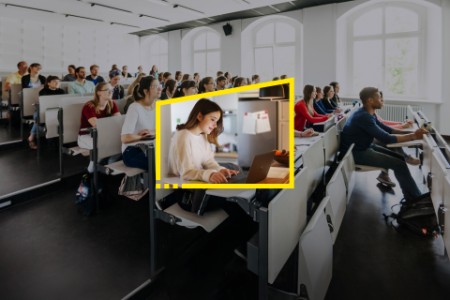Digital is setting the stage for immense innovation. In a world of “work from anywhere,” people also want to “learn from anywhere.” New education platforms are rising to meet this demand.
We are seeing a tension in higher education between:
- Traditionalists: (particularly in elite institutions) who look at the ever-rising prices and current demand profiles, and say that the model is secure
- Revolutionaries: who look at falling birth rates, pressure on affordability, the costs and benefits of digitization, and emerging new competitors, and say that the current model is under existential pressure
Revolutions have been very few in higher education. But our thesis is that, while both opinions describe parts of the higher education landscape, the revolutionaries are describing the larger portion.
Many of our universities face substitution risk and will not survive exponential technological change.
Universities must reinvent themselves. But reinvention is challenging when organizations are trapped by today’s assumptions. To help university leaders form a credible vision of their institution’s role in the new future of higher education, EY has developed a thought experiment, exploring how converging technologies, shifting demographics and new business models might change the sector’s structure.
The report is based on provocative EY thinking and interviews with a diverse range of university leaders, spanning developed and emerging markets, public and private institutions, and venerable and modern faculties to understand the challenges the education sector is facing as a result of the move towards greater digitalization.

Chapter 1
5 plausible “What if?” scenarios
We challenge you to think the unthinkable.
Try this thought experiment to shake off today’s norms and consider what the future may hold for your university. For more details of each scenario and their likely implications for the sector, download the report.
1. What if… the cost of learning is driven down to zero?
Imagine that learning and gaining qualifications in 2030 is as convenient as shopping or banking in 2021, and is possible to do at a very low cost. You can access your learning “account” online and complete course modules or entire degree programs from the best providers, anywhere in the world, at your own pace. The learning journey becomes hybrid, taking the best that online and in-person modes can offer, and flexing to your individual needs.
We have a whole generation of young people who are more open to online learning and given a choice, they might opt for different formats. They might actually want 60% of the class online and maybe 20% in lectures, then maybe 20% through internships or other kinds of experiences.
2. What if… learning journeys are entirely flexible and customizable?
Imagine that accessing educational content in 2030 is like listening to music via Spotify in 2021. At the touch of a screen, you access catalogs of learning content from the best providers in the world. Algorithms take you deeper into topics of interest and artificial intelligence matches learning activities with your current knowledge levels, learning preferences, career aspirations and learning goals.
You have to think, what can you be distinctive at? If you have an online offering, it is almost infinitely scalable, but the customer will also be free to choose the best provider. So, you have to offer something really good and distinctive.
3. What if… higher education providers are accountable for results?
Imagine that investing in knowledge in 2030 is as easy as investing in exchange-traded funds in 2021. All the programs on your independent career platform are independently rated based on inputs and outcomes declared by learning providers. Inputs include teacher-student ratios, and the amount, nature and quality of teaching and evaluation methods. Outcomes go beyond academic attainment and skills acquisition, covering a graduate’s employability and earning potential.
Is it not time now to have a proper student-university contract with great clarity? I would, for instance, make universities disclose their size of seminars and hold them contractually to it.
4. What if… commercialized research pays for itself?
Imagine that revenue from commercialized research in 2030 is sufficient to allow research to pay for itself. Universities have a clear understanding of what research lends itself to commercialization, gain access to private equity capital and participate in rich innovation ecosystems, facilitated by venture studios. Government funding focuses more on solving the major societal issues that the private sector cannot tackle alone, or on pure research to boost national competitiveness.
The (pending) ‘Endless Frontiers Act’, would significantly increase the size of the National Science Foundation and add an entire new directorate to it that would add a focus new to NSF on translational research.
Of the UN’s Sustainable Development Goals, health and education are two where, if we deploy technology creatively, we can actually get close to at least making a dent in it. Potentially, you can reach everyone [because] ... at least a large proportion of the population has a mobile phone.
5. What if… technology could solve the global supply-demand mismatch?
Imagine that, in 2030, a talented postgraduate engineering student in Luanda (Angola) could access the best, leading-edge teaching from the recognized leader in her field, without having to leave her hometown. Her self-accessed, remote learning is supplemented with occasional trips to her local campus for instructor-led teaching, delivered via video link from her professor in the US, or to use the campus laboratories. Her course fees are comparable to those of a local university degree, but she leaves with sought-after, recognized and internationally transferable credentials.

Chapter 2
Time to think future-back
How to repeat this thought experiment to prepare for what is coming.
I think everybody has to innovate, but the number that is able to make progress is small. The industry does not have the change leadership and strategic development capability.
To survive and thrive in the knowledge services sector, universities must reinvent themselves by jumping the S-curve — moving from the maturity stage to the growth stage.

If they are to innovate at the speed and scale needed to survive, universities must take a “future-back” approach, consider plausible (if confronting) future scenarios and imagine how their operating models may need to radically transform to remain competitive.
Key recommendations:
- Be clear about your long-term purpose
Is your purpose to advance lifelong education well-being, collaborate to solve global challenges, unlock knowledge and commercialize research, or something else?
- Think “future-back” to set your reinvention agenda
Consider possible future scenarios to define the choices you need to make today to remain relevant in one or two decades. Engage your broader ecosystem to think differently about possible futures.
- Build new value with new capabilities
In future, value will come from putting humans at the center, driving innovation at scale and deploying technology at speed. To build these competencies, go outside your sector to find leadership talent from other industries living with reinvention, such as retail, media or financial services.
- Invest across the three time-horizons
Horizon Now (50%): strengthen the core. Horizon Next (40%): build new business models. Horizon Beyond (10%): make big bets to reinvent yourself.
The future is closer than you think. To remain relevant, universities must reinvent themselves. Change must start now — before it is too late.
The quality of life we have today is the product of the research and the learning of prior generations. What does this moment in history demand of our education and research institutions, in order to deliver the technological, scientific and cultural advances humankind — and the planet — need for tomorrow?
Summary
Universities need to innovate for a future that accommodates both degrees and micro-credentials, intellective and job-ready skills, and synchronous and asynchronous learning, using online or hybrid delivery models. Scenario planning will support a “future-back” approach to help university leaders envision a new era for higher education.


